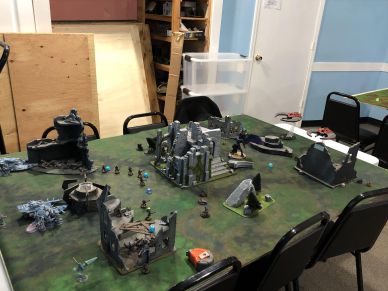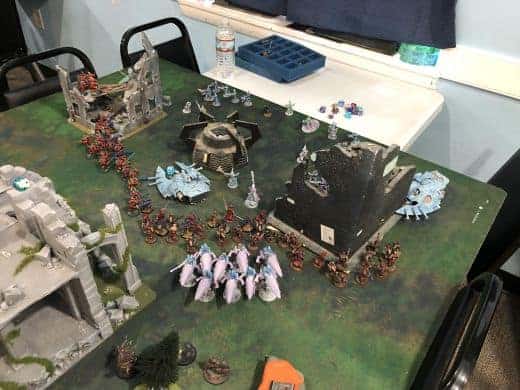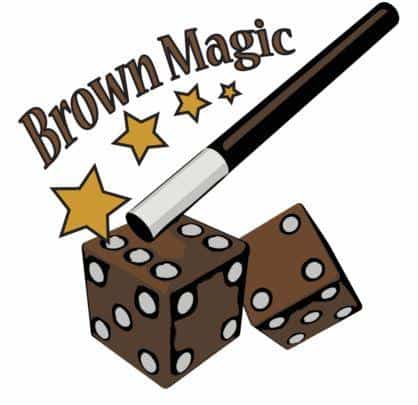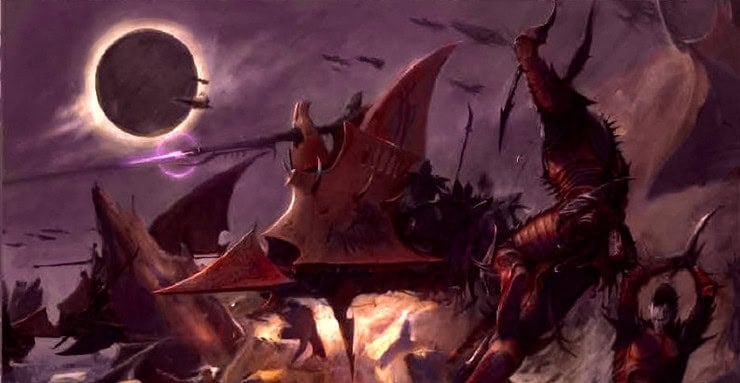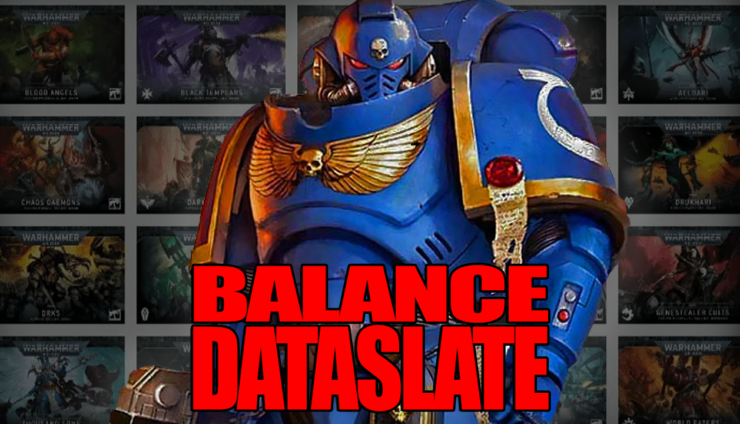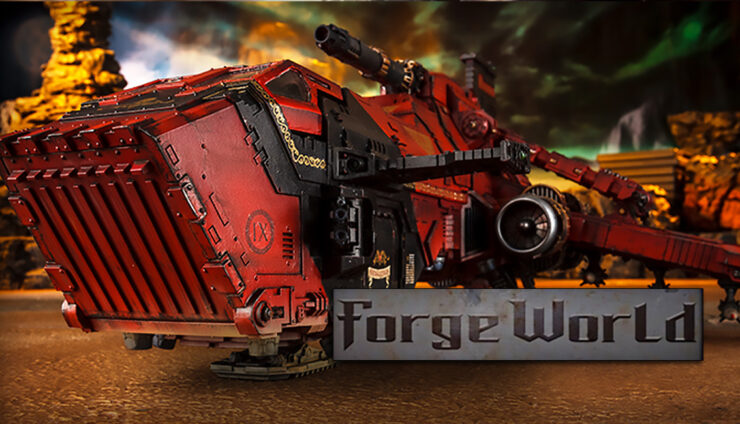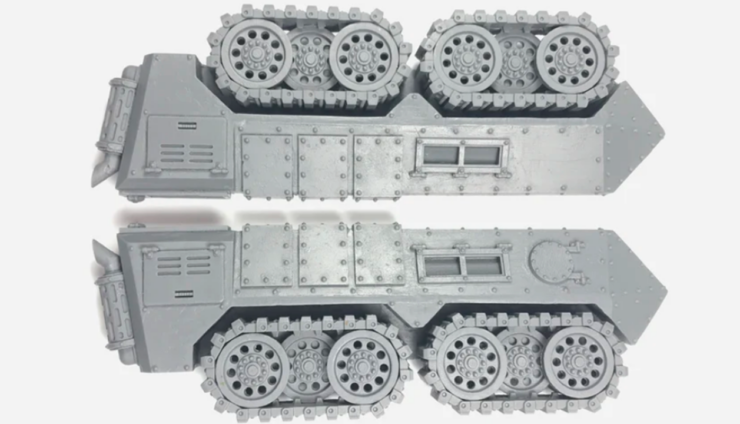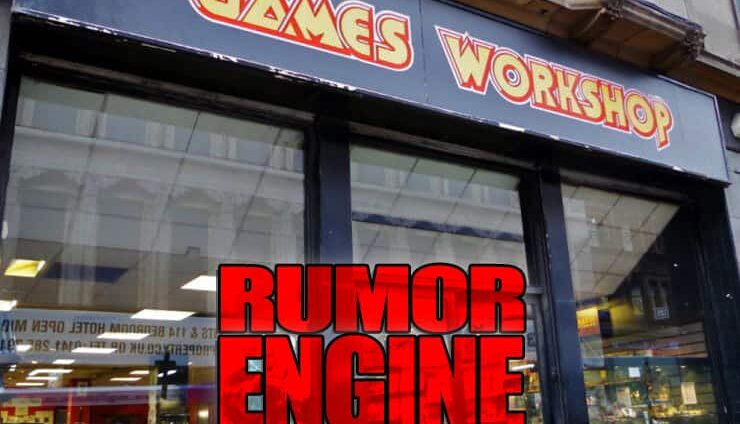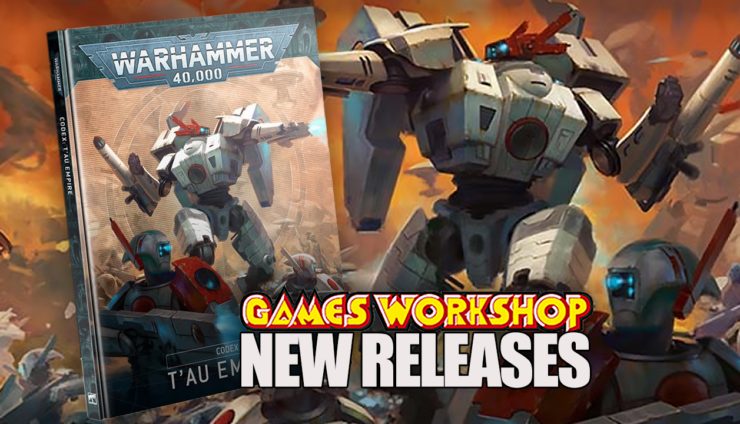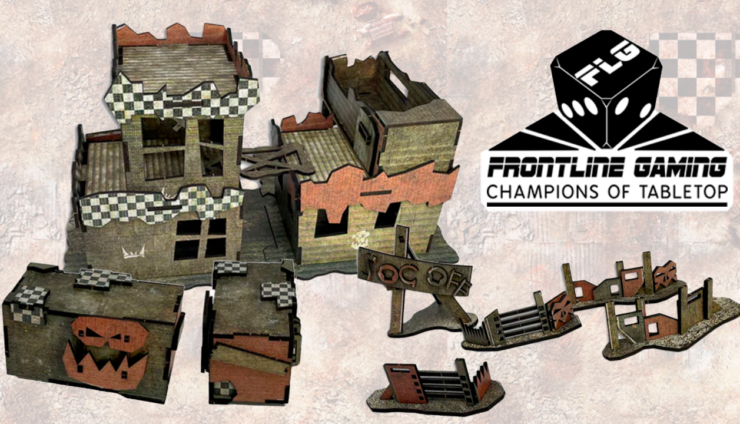What can you be doing to play better tabletop games? Come see 4 big tips for getting the best dice rolls possible in part two of Brown’s play better series.
Last week, I began my epic on how to move past rolling poorly as a player by covering the concept of risk management in 40k. If you missed that be sure to catch it here. Today, I’m going to continue this series by going over some examples of tactics you can use in-game to mitigate the impact dice have by reviewing a game I’ve previously played here: Goals Aren’t Just for Soccer Part 2.
To get the full recap here of what happened in the game I recommend clicking the link above. I know how lazy gamers can be though, so if you don’t click it because context is for squares, I completely understand.
This is a reenactment of my round two game of LVO vs Josh Conant and his Chaos army. The two Night scythes back there are playing a bad game of pretend, but they actually count as fire raptors. In short, Josh has Magnus, 2 Fire Raptors, a bloodletter bomb in reserve, and an infiltrating alpha legion cultist blob. I’m playing my LVO winning list.
As you can see from the picture my deployment is fairly conservative. Despite having the +1 to go first in this scenario, I didn’t want to be hung out to dry if I lost the roll or got seized on, so I deployed accordingly. Screens on the line, wave serpents in cover and far away, and random people scattered about to zone out potential deeps strikes and infiltrates.
Lo and behold, I got seized on. Good thing I was prepared for that!
As you can see on Josh’s turn 1 he moved up, shot some serpents, and then charged my front lines with the bloodletters and cultists, surrounding models to prevent me from falling back. Josh wasn’t able to kill a serpent with shooting in this instance, due to cover saves and aliatoc, but had he, I wouldn’t have been screwed. Both serpents were positioned far enough away from the front lines that in the event of a seize and 1 dying to shooting, the contents could disembark far enough away to avoid being charged and out of LOS of the fire raptors. At this point I have a contingency plan in place for something at the ~5% probability interval for that unfortunate series of events. This is the kind of contingency planning and foresight which will really help you mitigate poor dice in your games.
This is a picture after my bottom of 1 movement phase. The bloodletters and cultists charged at the end of Josh’s turn as described before. I responded by disembarking everyone, moving a serpent up, and deep striking my spears. Here you can see all my key psykers hugging my board edge to ensure they are out of deny range of Magnus. In general, I make sure to stay out of deny range at all times unless absolutely necessary. In this case, it’s fairly obvious since Magnus is meany head with +2 to deny and 3 attempts, but I would do this same kind of thing against a little astropath wandering about in midfield as well.
In general, giving yourself as few points of failure as possible is key to success.
This is the same turn after casting an undeniable quicken onto my spears. They moved behind the cultists with the intent of killing them, but are also within 7″ of the nurglings so they can kill them and trigger a soul burst to finish the cultists if need be. This is an idea of redundancy and it’s one of the best ways to remove dice from the equation. The spears were fairly likely to bring the cultists to a point where they will crumble to morale (which is all I needed to accomplish here), but it’s within reason that they fail to do so because whiffs can happen. Thus, I put them in a position to allow them to fight twice via soul burst if need be.
I typically try and always set myself up to completely overkill units when making plans, as opposed to trying to maximize efficiency by planning my turn around units dying when they should.
A prime example of this is when my reapers shot the two fire raptors in the above scenario. In my plan, I based my turn around the fact that I can very reliably put down 1 raptor, but the other will probably live. I moved accordingly and planned as though that would happen. I guided the big reaper unit and soul burst shot them at one of the fire raptors bringing it down to 7 wounds. I then shot all my 3 mans at it and only managed to bring it down to 4 wounds. At this point, I was down to just my second round of shooting with the guided big unit, and there were still 2 raptors (though one was down to 4 wounds).
 Quick reaper math time! A raptor with 4 wounds left needs to fail 2- 5+ saves to die to reapers. 2 failed saves comes from 3 wounds. To generate 3 wounds you’d need 4-5 hits. To get 4-5 hits off guided reapers 5 shots should reasonably do it. A play based on statistically expected results would be to shoot 5 reapers at the wounded raptor, and the remaining 3 at the other raptor to try and chip it a bit. A 6 and 2 split if you really wanted to be safe about it. However, a better move would be to over-commit and shoot all 8 at the wounded raptor. While this should statistically obliterate it, and most likely end up with a bunch of wasted damage, that’s ok!
Quick reaper math time! A raptor with 4 wounds left needs to fail 2- 5+ saves to die to reapers. 2 failed saves comes from 3 wounds. To generate 3 wounds you’d need 4-5 hits. To get 4-5 hits off guided reapers 5 shots should reasonably do it. A play based on statistically expected results would be to shoot 5 reapers at the wounded raptor, and the remaining 3 at the other raptor to try and chip it a bit. A 6 and 2 split if you really wanted to be safe about it. However, a better move would be to over-commit and shoot all 8 at the wounded raptor. While this should statistically obliterate it, and most likely end up with a bunch of wasted damage, that’s ok!
Had I gone with the statistically expected play but the dice spiked leaving both raptors alive, I would’ve been in an incredibly bad situation due to the fundamental failure in my plan of killing 1 raptor. Also, what value am I really gaining by taking 2 “free” reaper shots at an unmolested fire raptor? Basically, none, especially when you consider that it comes at an enormous risk.
There are so many more examples of where to try and use known factors and good decision-making skills to limit the impact dice can have on your game, but this game does a good job highlighting a few key concepts.
In Summary:
- Deploy and move for the worst case scenarios occurring. (Plan like a pessimist)
- Minimize points of failure by limiting the amount of times dice are rolled. (Ex. staying out of denying range when casting)
- Set up redundancy when trying to kill units, so if a unit survives longer than it should, you have back up plans. (Set up safety nets and fallbacks)
- It’s better to overkill a unit than to get greedy and not kill anything. (This may seem obvious, but see the reaper example)
It’s easy enough to come up with a good plan that should work, then blame dice when it doesn’t, but ultimately, this will be your biggest downfall. You will never grow as a player until you break that mentality. Instead of looking at it from the perspective of “I played well, had a good plan, but then the dice betrayed me.“, look at it like “What could I have done differently to not been vulnerable to rolling poorly and losing.”
You need to be objective. It is much more likely that you could have made an earlier series of moves which would have put you in a position where you weren’t even susceptible to rolling poorly.
Hopefully, this will give you some ideas on what to look out for and how to mitigate dice in your own games!

